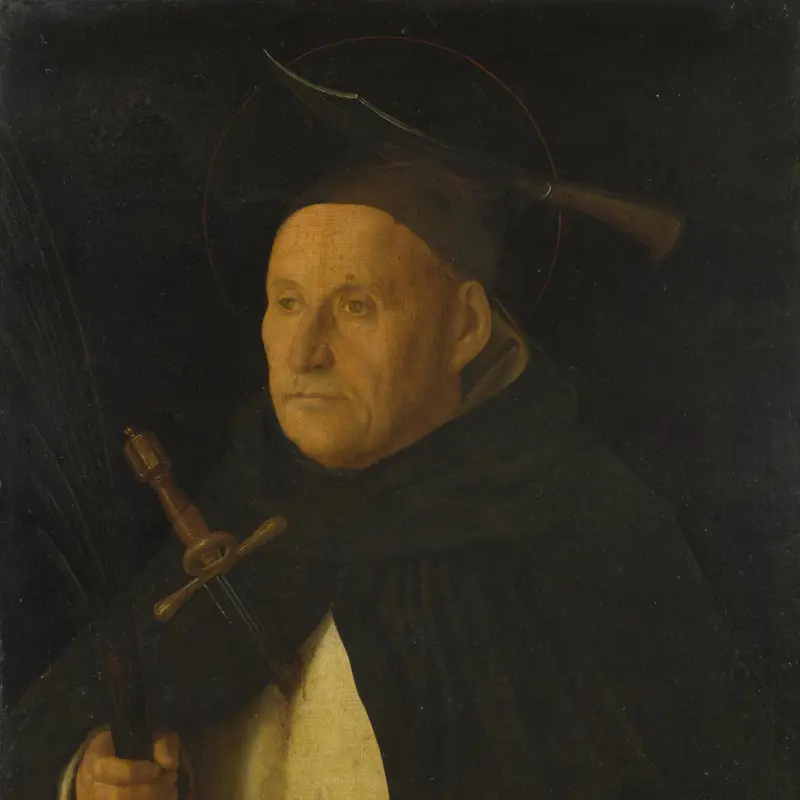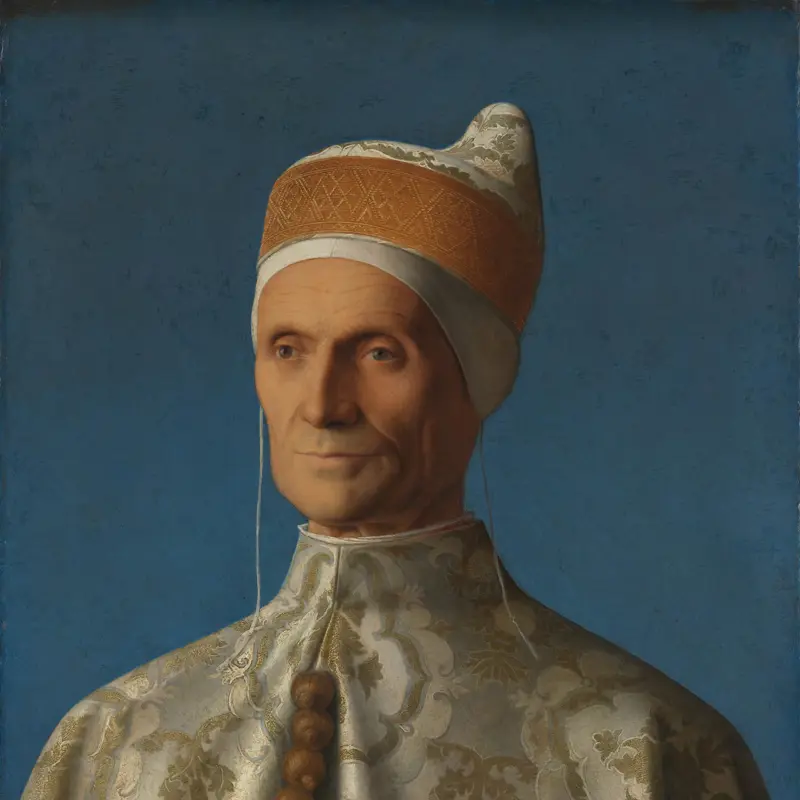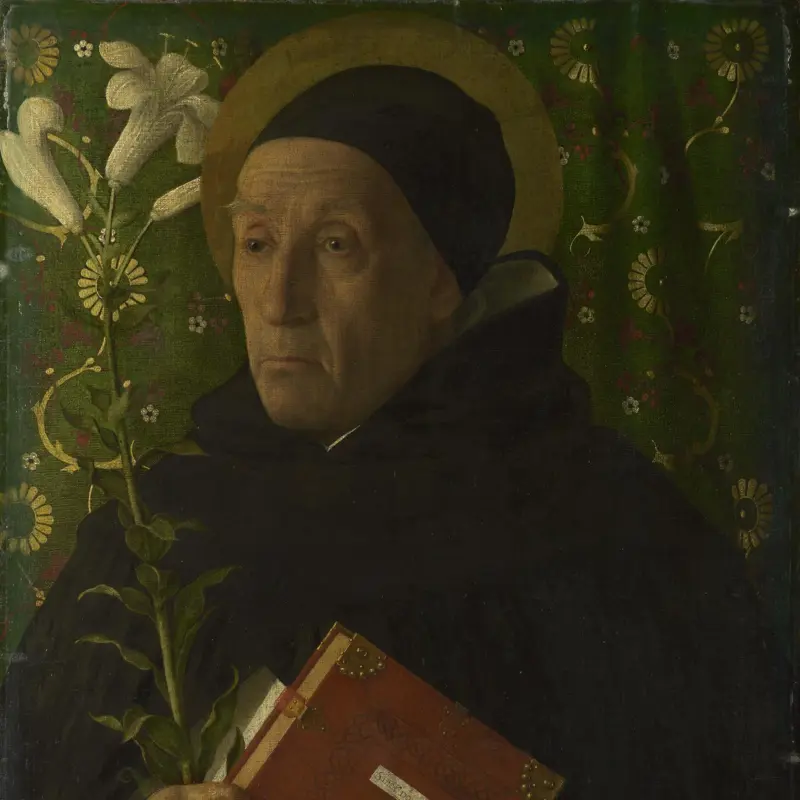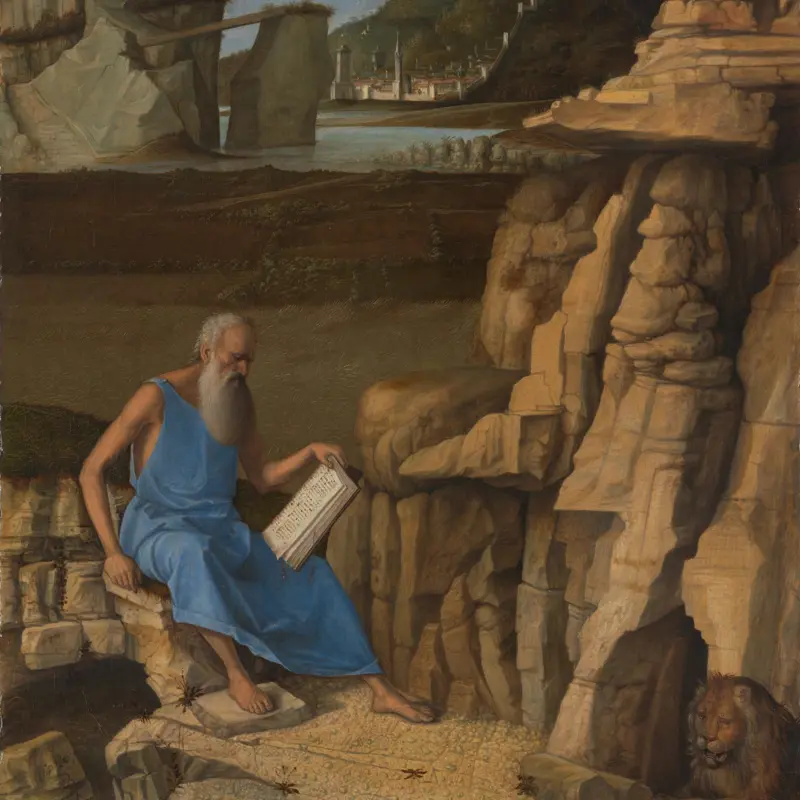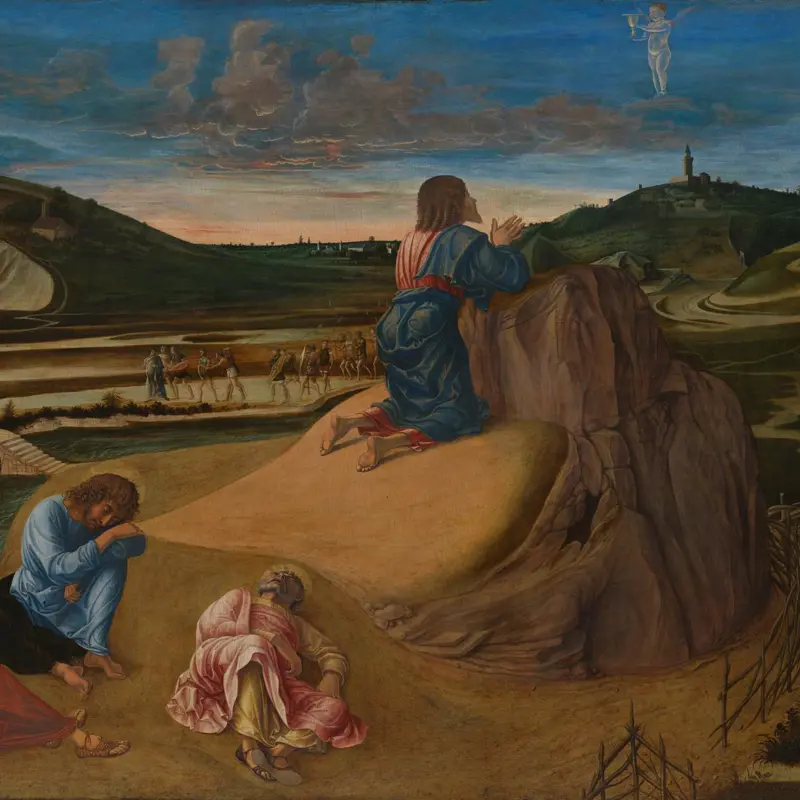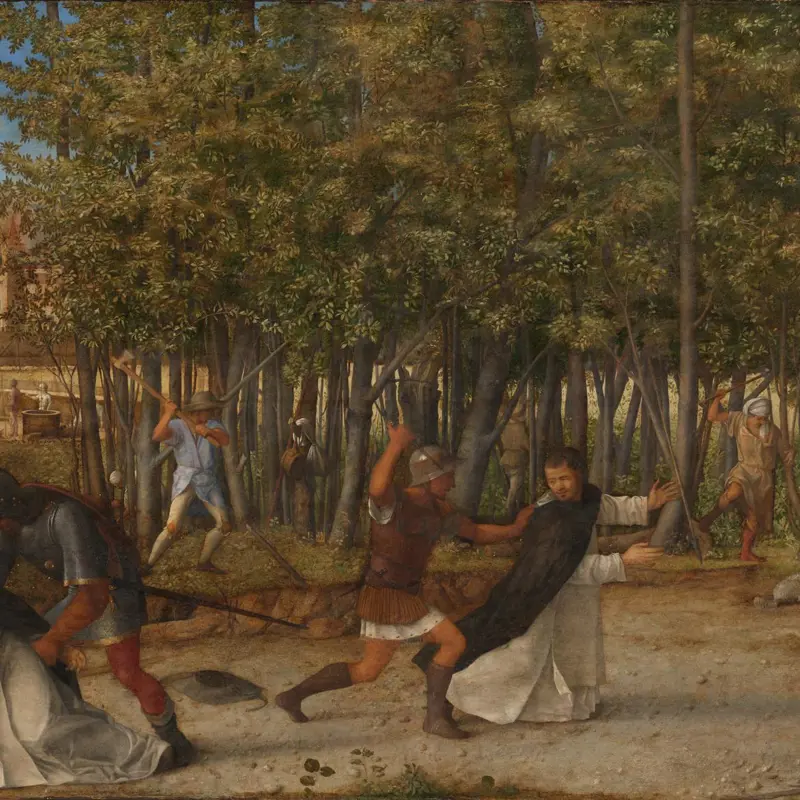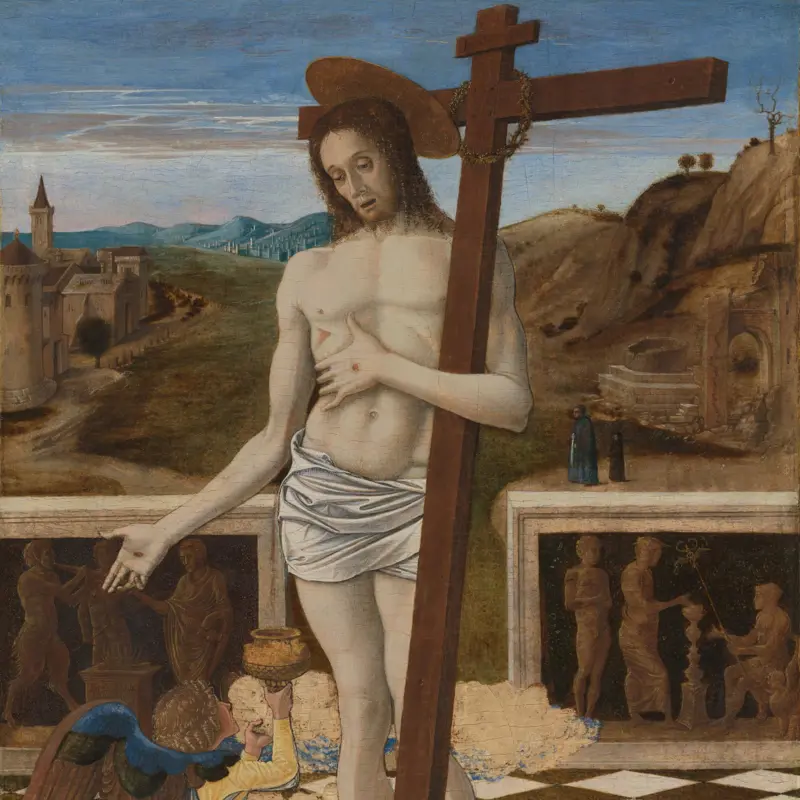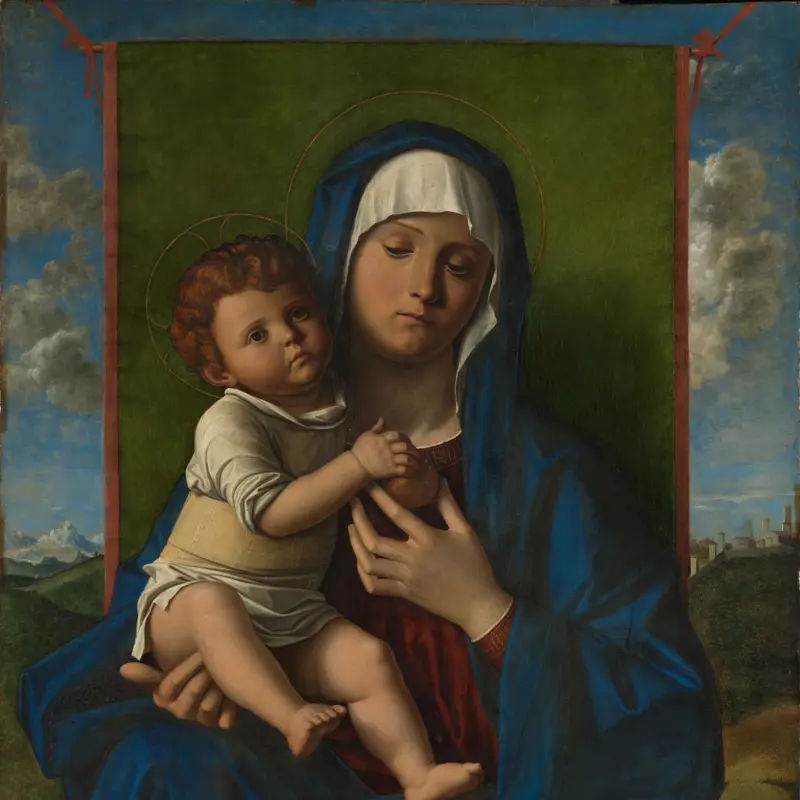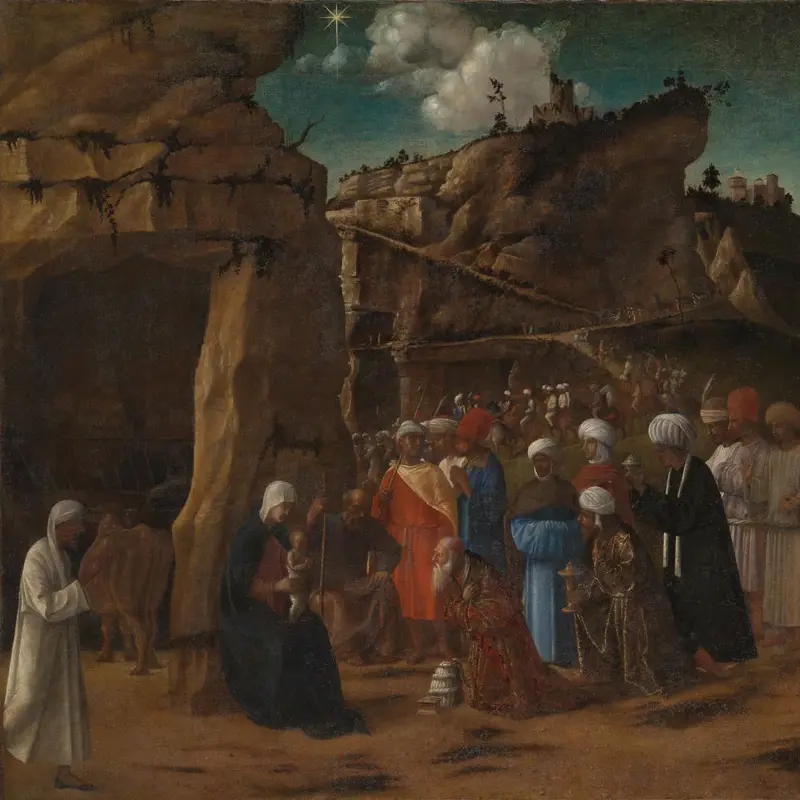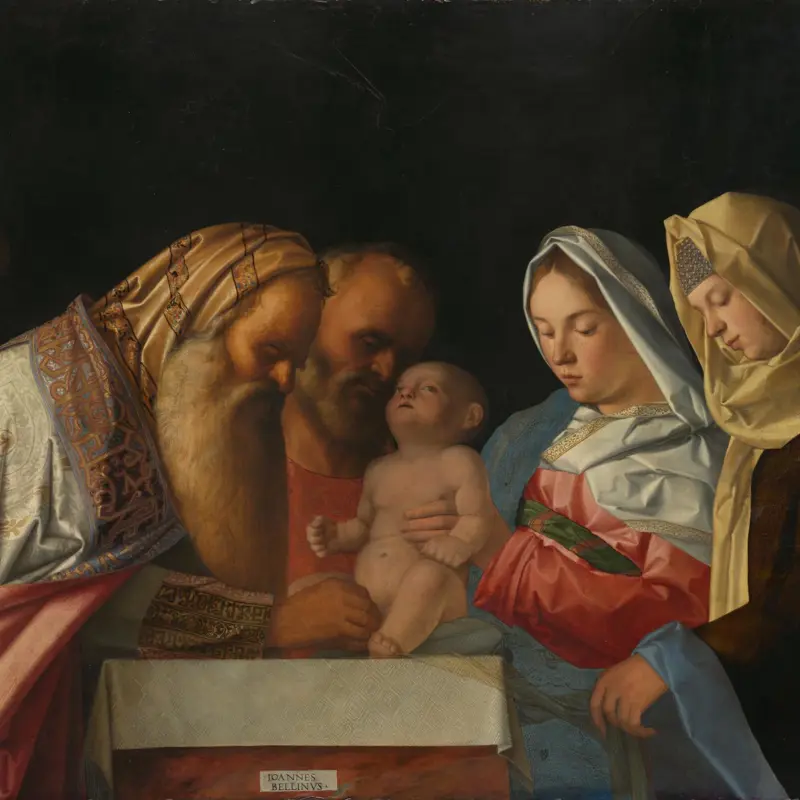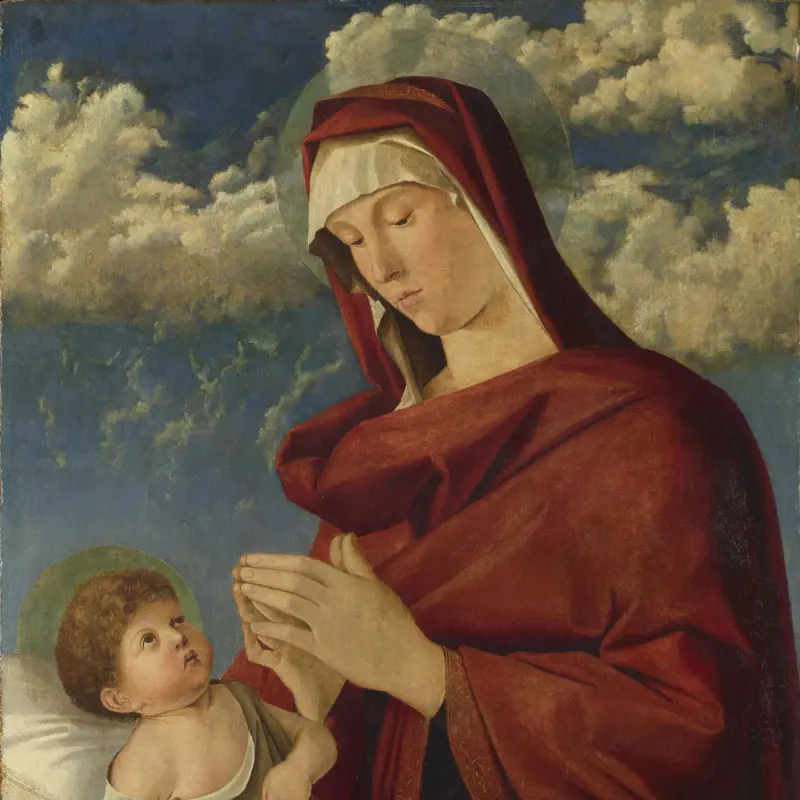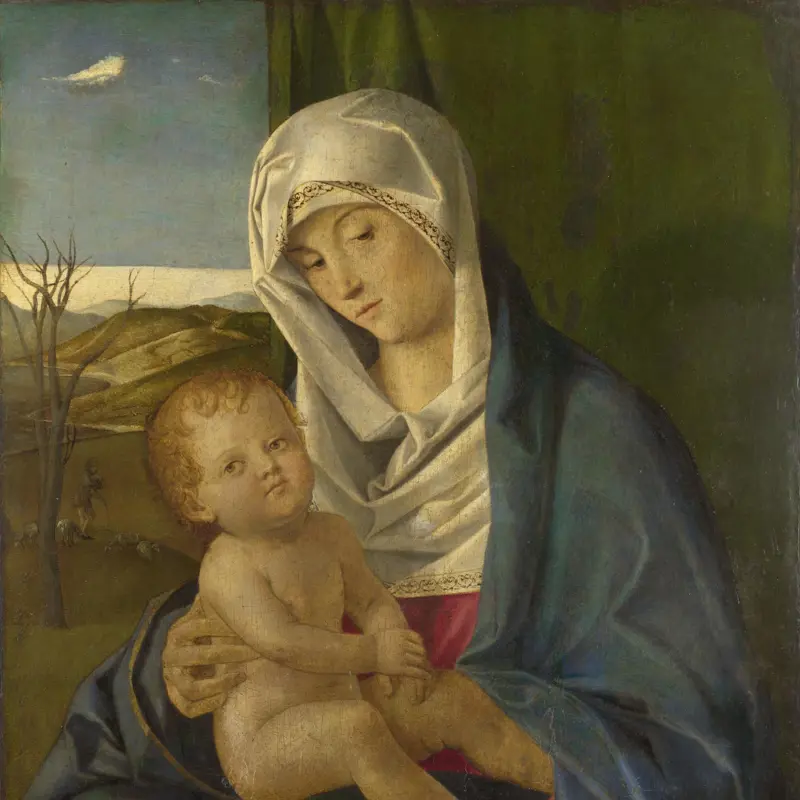Giovanni Bellini, 'Madonna of the Meadow', about 1500-5
About the work
Overview
The Virgin Mary adores the Christ Child sleeping on her lap. Giovanni Bellini was one of the first Italian painters to use natural settings to enhance the meaning of his pictures. Here, the still Virgin contrasts with the landscape, where the varying shapes of the clouds, from thin and wispy to fat and fluffy, and the shadows on them give the impression of changeable weather. The clarity of the light, which casts a pale glow on everything it touches, from the Virgin’s right sleeve to the walls of the castle in the distance, suggests it is springtime.
Christ’s pose would have reminded contemporary viewers of a type of picture known as the Lamentation, or pietà, which showed Christ after his death lying across his mother’s knees. And yet the carefully observed landscape evokes hopefulness: spring is a time of renewal in nature and of Easter, the moment of Christ’s resurrection from the dead.
Key facts
Details
- Full title
- Madonna of the Meadow
- Artist
- Giovanni Bellini
- Artist dates
- About 1435 - 1516
- Date made
- About 1500-5
- Medium and support
- Oil, originally on wood, transferred to composite board
- Dimensions
- 66.5 × 85.1 cm
- Acquisition credit
- Bought, 1858
- Inventory number
- NG599
- Location
- Room 63
- Collection
- Main Collection
- Frame
- 16th-century Italian Frame
Provenance
Additional information
Text extracted from the ‘Provenance’ section of the catalogue entry in Martin Davies, ‘National Gallery Catalogues: The Earlier Italian Schools’, London 1986; for further information, see the full catalogue entry.
Exhibition history
-
2011Art for the Nation: Sir Charles Eastlake at the National GalleryThe National Gallery (London)27 July 2011 - 30 October 2011
-
2012Titian's First Masterpiece: The Flight Into EgyptThe National Gallery (London)4 April 2012 - 19 August 2012
-
2018Mantegna and BelliniThe National Gallery (London)1 October 2018 - 27 January 2019
-
2018Mantegna and Bellini: Masters of the RenaissanceGemäldegalerie (Berlin)1 March 2019 - 30 June 2019
Bibliography
-
1859R.N. Wornum, Descriptive and Historical Catalogue of the Pictures in the National Gallery with Biographical Notices of the Painters: Foreign Schools, 29th edn, London 1859
-
1859London, National Gallery Archive, dossier for NG 599: Report of the Director of the National Gallery…4 April 1859, 4 April 1859
-
1867A.A. Lavice, Revue des musées d'Angleterre, Paris 1867
-
1871J.A. Crowe and G.B. Cavalcaselle, A History of Painting in North Italy: Venice, Padua, Vicenza, Verona, Ferrara, Milan, Friuli, Brescia, from the Fourteenth to the Sixteenth Century, 2 vols, London 1871
-
1878H. Blackburn, Illustrated Catalogue to the National Gallery: Foreign Schools, London 1878
-
1879G. Frizzoni, 'L'arte italiana nella Galleria Nazionale di Londra', Archivio storico italiano, IV/113, 1879, pp. 246-81
-
1883J.P. Richter, Italian Art in the National Gallery, London 1883
-
1887F. Kugler, Handbook of Painting: The Italian Schools, eds C.L. Eastlake and A.H. Layard, 5th edn, London 1887
-
1887M.-F. Reiset, Une visite à la Galerie nationale de Londres, 2nd revised edn, Rapilly 1887
-
1887W. Armstrong, 'Notes on the National Gallery', The Guardian, 1887
-
1888E.T. Cook, A Popular Handbook to the National Gallery Including, by Special Permission, Notes Collected from the Works of Mr. Ruskin, London 1888
-
1891G. Frizzoni, 'L'arte italiana nella Galleria Nazionale di Londra', in G. Frizzoni, Arte Italiana del Rinascimento, Milan 1891
-
1895C. Monkhouse, In the National Gallery, London 1895
-
1895C.E. Smith, Journals and Correspondence of Lady Eastlake, London 1895
-
1898National Gallery, Descriptive and Historical Catalogue of the Pictures in the National Gallery, with Biographical Notes of the Painters: Foreign Schools, 78th edn, London 1898
-
1901A. Venturi, Storia dell'arte italiana, 11 vols, Milan 1901
-
1901E. Jacobsen, 'Italienische Gemälde in der National Galerie zu London: Kritische Notizen zum Katalog von 1898', Repertorium für Kunstwissenschaft, XXIV, 1901
-
1906Half Holidays at the National Gallery, 5th edn, London 1906
-
1913National Gallery, Descriptive and Historical Catalogue of the British and Foreign Pictures, 81st edn, London 1913
-
1914G. Cantalamessa, 'La Madonna de Giovanni Bellini nella Galleria Borghese', Bollettino d'arte, VIII, 1914
-
1923R. van Marle, The Development of the Italian Schools of Painting, 19 vols, The Hague 1923
-
1923National Gallery, National Gallery, Trafalgar Square: Illustrations to the Catalogue, vol. 1, Italian Schools, London 1923
-
1928G. Gronau, Spätwerke des Giovanni Bellini, Strasbourg 1928
-
1928G. Gronau, 'Le opere tarde di Giovanni Bellini', Pinacotheca, 1928, pp. 57-70, 115-31, 171-7
-
1929National Gallery, National Gallery, Trafalgar Square: Catalogue, 86th edn, London 1929
-
1930G. Gronau, Giovanni Bellini, Stuttgart 1930
-
1932B. Berenson, Italian Pictures of the Renaissance: A List of the Principal Artists and Their Works, with an Index of Places, Oxford 1932
-
1935L. Düssler, Giovanni Bellini, Frankfurt 1935
-
1937C. Gamba, Giovanni Bellini, Milan 1937
-
1938R. Wittkower, 'Eagle and Serpent, a Study in the Migration of Symbols', Journal of the Warburg and Courtauld Institutes, II, 1938, pp. 293‑325
-
1943V. Moschini, Giambellino, Rome 1943
-
1949K. Clark, Landscape into Art, New York 1949
-
1949L. Düssler, Giovanni Bellini, Vienna 1949
-
1950E. Wind, 'The Eloquence of Symbols', The Burlington Magazine, XCII/573, 1950, pp. 349-50
-
1951Davies, Martin, National Gallery Catalogues: The Earlier Italian Schools, London 1951
-
1957B. Berenson, Italian Pictures of the Renaissance: A List of the Principal Artists and Their Works, with an Index of Places: Venetian School, 2 vols, London 1957
-
1959R. Pallucchini, Giovanni Bellini, Milan 1959
-
1961M. Davies, The Earlier Italian Schools, 2nd edn, London 1961
-
1962F. Heinemann, Giovanni Bellini e i Belliniani, 3 vols, Venice 1962
-
1963S. Bottari, Tutta la pittura di Giovanni Bellini, Milan 1963
-
1966A.R. Turner, The Vision of Landscape in Renaissance Italy, Princeton 1966
-
1966M. Meiss, 'Sleep in Venice: Ancient Myths and Renaissance Proclivities', Proceedings of the American Philosophical Society, CX/5, 1966, pp. 348-82
-
1968G. Robertson, Giovanni Bellini, Oxford 1968
-
1969T. Pignatti, L'opera completa di Giovanni Bellini, Milan 1969
-
1969H. Ruhemann and J. Plesters, The Cleaning of Paintings, London 1969
-
1969D. Cast, 'The Stork and the Serpent, a New Interpretation of the Madonna of the Meadow by Bellini', Art Quarterly, XXXII, 1969, pp. 247-57
-
1972N. Huse, Studien zu Giovanni Bellini, Berlin 1972
-
1972C. Gould, The Draped Figure, London 1972
-
1974Virgil, Virgil, vol. 1, Georgics, trans. H.R. Fairclough, Cambridge MA 1974
-
1977J. Mills and R. White, 'Analyses of Paint Media', National Gallery Technical Bulletin, I, 1977, pp. 57-9
-
1977A. Caro, The Artist's Eye: An Exhibition Selected by Anthony Caro at the National Gallery, London 1977
-
1978D. Robertson, Sir Charles Eastlake and the Victorian Art World, Princeton 1978
-
1986Davies, Martin, National Gallery Catalogues: The Earlier Italian Schools, revised edn, London 1986
-
1989R. Goffen, Giovanni Bellini, New Haven 1989
-
1991J. Dunkerton et al., Giotto to Dürer: Early Renaissance Painting in the National Gallery, New Haven 1991
-
1992A. Tempestini, Giovanni Bellini. Catalogo completo dei dipinti, Florence 1992
-
1993C. Wood, Albrecht Altdorfer and the Origins of Landscape, London 1993
-
1993A. Steinberg, 'Blurred Boundaries, Opulent Nature, and Sensuous Flesh: Changing Technological Styles in Venetian Painting, 1480-1520', Studies in the History of Art, XLV, 1993, pp. 198-220
-
1994A.F. Janson, 'The Meaning of Landscape in Bellini's St Francis in Ecstasy', Artibus et historiae, XV/30, 1994, pp. 41‑54
-
1995P. Humfrey, Painting in Renaissance Venice, New Haven 1995
-
2001
C. Baker and T. Henry, The National Gallery: Complete Illustrated Catalogue, London 2001
-
2004S. Miscellaneo, L'archivio della confraternita e ospedale di S. Maria del Prato (1320-1808): Per una storia dell'assistenza a Feltre attraverso i documenti delle confraternite, Rasai di Seren del Grappa 2004
About this record
If you know more about this work or have spotted an error, please contact us. Please note that exhibition histories are listed from 2009 onwards. Bibliographies may not be complete; more comprehensive information is available in the National Gallery Library.

